Panthera atrox was about 25 percent larger than modern lions
Advertisement
Panthera atrox (American Lion) Scientific Classification
- Kingdom
- Animalia
- Phylum
- Chordata
- Class
- Mammalia
- Order
- Carnivora
- Family
- Felidae
- Genus
- Panthera
- Scientific Name
- Panthera atrox
Read our Complete Guide to Classification of Animals.
Panthera atrox (American Lion) Conservation Status
Panthera atrox (American Lion) Facts
- Prey
- Large mammals such as bison, horses, sloths, mammoths, deer.
- Main Prey
- American bison
- Group Behavior
- Pair
- Fun Fact
- Panthera atrox was about 25 percent larger than modern lions
- Biggest Threat
- Climate change, human activities
- Most Distinctive Feature
- Panthera atrox had long limbs
- Other Name(s)
- North American lion, American cave lion
- Habitat
- Open grasslands and savannas
- Diet
- Carnivore
- Favorite Food
- American bisons and other large mammals
- Type
- Lion
- Common Name
- American lion
- Special Features
- The American lion was bigger than modern lions
- Origin
- North America
View all of the Panthera atrox (American Lion) images!
Panthera atrox—commonly known as “the American lion”—is an extinct species of lion native to the North American continent. The relationship between this lion and modern lion species has been contentious for years after its discovery. However, recent studies have revealed its close relationship with the cave lion. American lions ruled the North American continents for thousands of years. They, however, went extinct roughly 10,000 years ago.
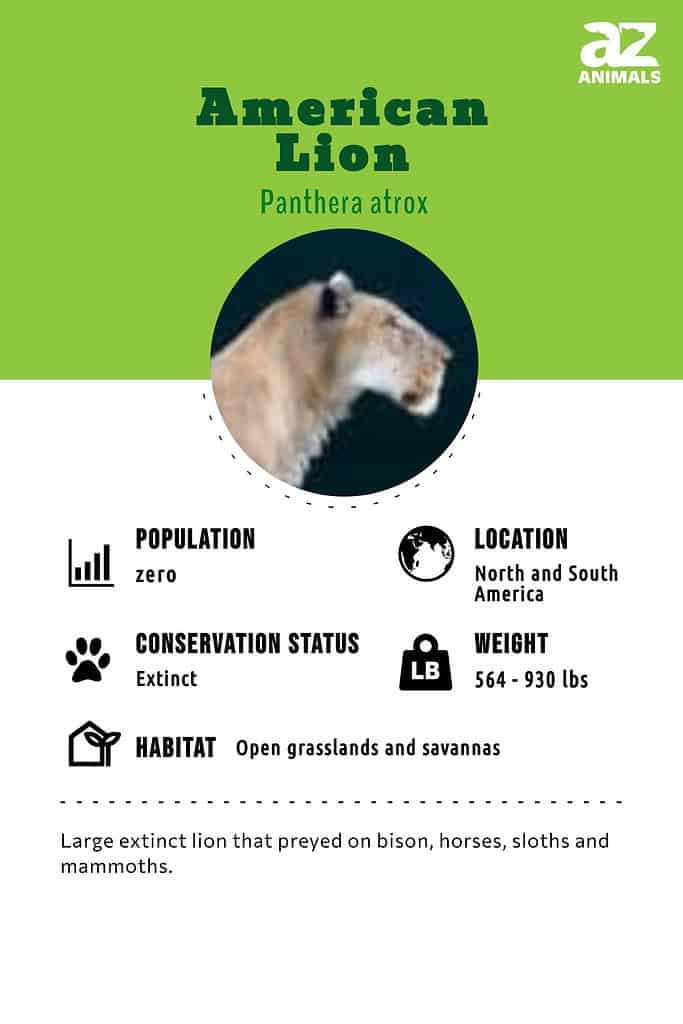
Evolution
The earliest fossil record of the genus, Panthera, dates to 3-4 million years ago and was found in Tanzania. Different species of this genus evolved and migrated all over the world.
Panthera atrox, the American cave lion, lived during the Pleistocene, as did other cave lions in Europe and Siberia. It is believed that the European cave lion crossed into North America across the Beringia Land Bridge from Europe. The American cave lion evolved adaptations to its new environment and diverged from the European cave lion around 340,000 years ago. The cave lion lineages were isolated from African and Asian lions since at least 600,000 years ago, according to DNA analysis.
Description and Size
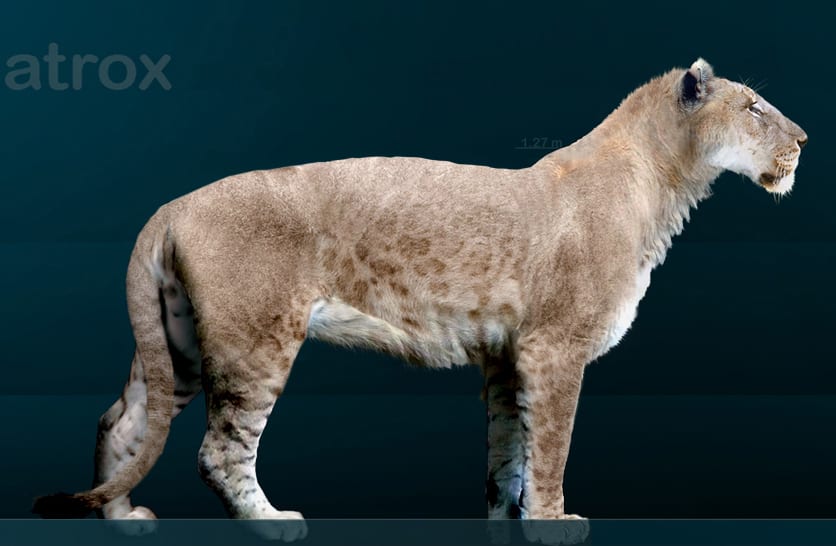
The American lion,
Panther atrox,lived in North America from the Pleistocene Epoch (340,000 years ago) until it went extinct 11,000 years ago.
©Sergiodlarosa / CC BY-SA 3.0 – License
Panthera atrox is more commonly known as the American lion. It is also called the North American lion or American cave lion. The scientific name “Panthera atrox” is a Latin phrase that translates as “cruel” or “fearsome panther.” It lived in North America from the Pleistocene Epoch about 340,000 years ago before it went extinct about 11,000 years ago.
For years, the affinities of this lion remained a controversial subject. Experts thought it might have been related to the jaguar, tiger, or panther. However, more recent DNA studies have revealed that the American lion was a relative of the cave lion (also extinct). The only living close relative of Panthera atrox is the modern lion.
Since there’s an abundance of fossil materials on this lion, we have a relatively good picture of what it might have looked like. Scientists think it strongly resembled modern lions but was considerably larger.
The American lion was between 5.3 and 8.2 feet long and stood at about 3.9 feet from the ground to the shoulder. Weight estimates for this lion vary between 564 and 930 pounds. While the American lion was bigger than today’s lion, it was smaller than many of its extinct contemporaries, such as the Smilodon populator (a type of saber-toothed cat) and the North American giant short-faced bear, which was probably a direct competitor for food in the same habitat.
Based on some preserved skin remains of this lion, there are speculations that it might have had a reddish coloration. However, experts think it did not have a mane like modern lions.
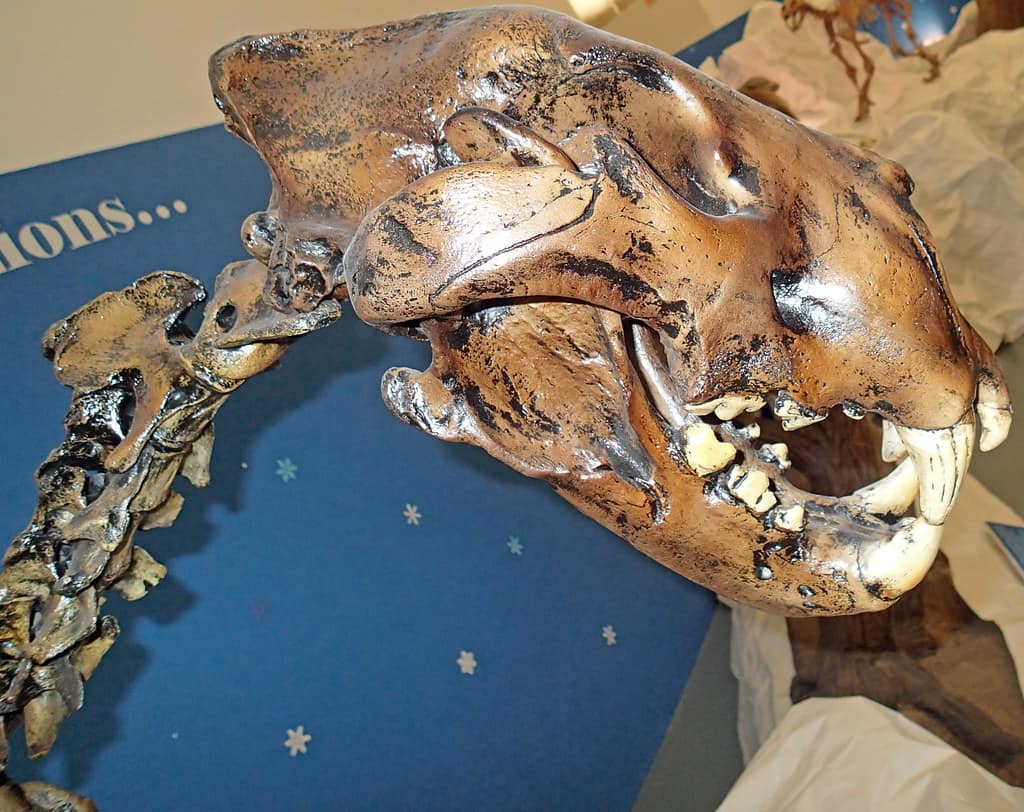
The muzzle of the cave lion, which closely resembles the American lion, was longer and narrower than modern lions.
©
Diet—What Did the Panthera atrox Eat?
The diet of the American lion is similar to those of its modern relatives. It probably preyed on wild horses, deer, tapir, mammoths, American bison, and other hoofed mammals that shared the same habitat with it. Paleontologists once found the mummified fossils of a bison that was frozen in ice in Alaska. The carcass had bite and claw marks from American lions, confirming that they predated bison.
Habitat–When and Where the Panthera atrox Lived
Panthera atrox lived in North America during the Pleistocene Epoch. Fossils of this lion have been discovered in various locations from Alaska to Peru. However, none have been found in the northeastern part of Canada and in the southern Florida area.
The American lion most likely lived in grasslands and savannas, similar to present-day lions. Since some parts of the typical range were characterized by cold climatic conditions, the lion probably took shelter in caves in these areas. Experts also think they lined their dens with leaves or grass like Siberian tigers.
Panthera atrox was probably an intelligent creature. Experts came to this conclusion because fossils of this lion are not as common as that of other predators that lived around the same period. This suggests that they learned to evade entrapments that killed other predators.
American lions were social but didn’t form a pride like modern lions. Instead, they probably formed hunting pairs to take down prey. The difference in the size of the skeletons of males and females suggests a type of sexual dimorphism.
Threats and Predators
The American lion shared the same ecological niche as the giant short-faced bear (Arctodus simus). Since this prehistoric bear was one of the largest known terrestrial mammalian carnivorans, both species would have competed for food quite often. Panthera atrox also lived alongside humans during the later part of its existence. Archeologists have found lion bones in trash heaps of native Americans from the Paleolithic Era. This suggests that the early humans hunted this carnivore for food.
Discoveries and Fossils—Where Panthera atrox Was Found
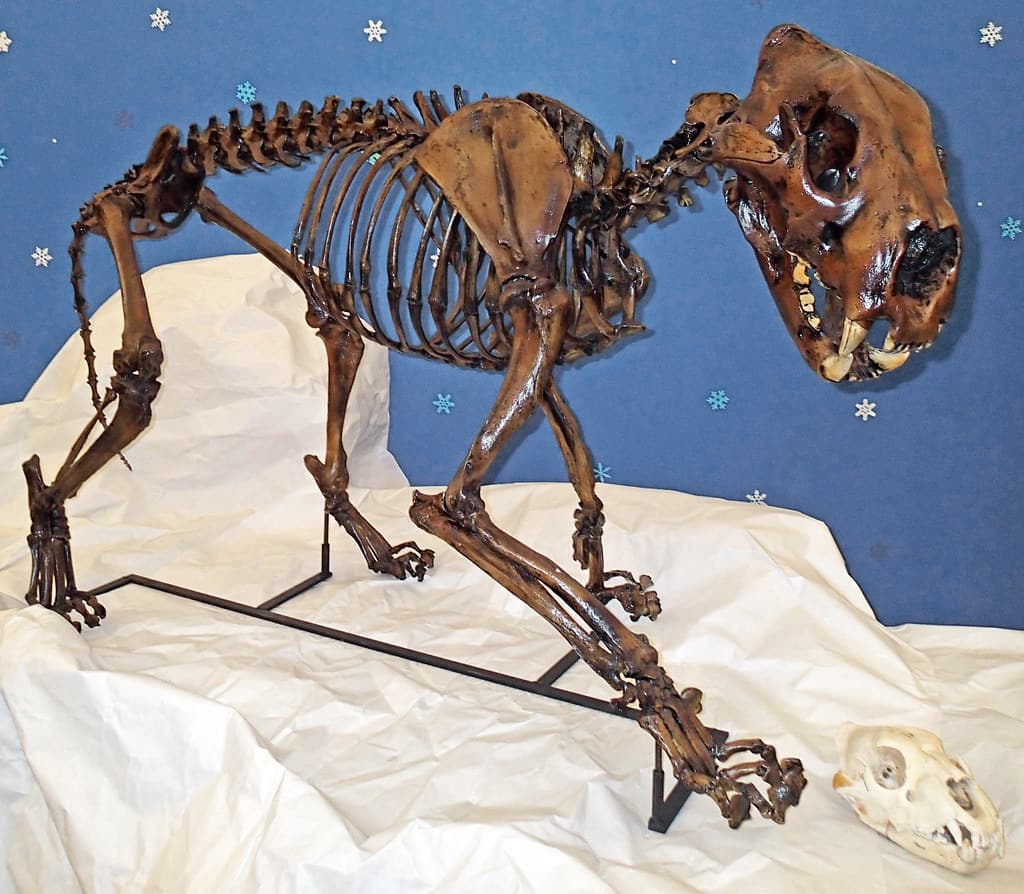
The first fossil of an American lion was discovered in Natchez, Mississippi in the 1830s.
©James St. John / CC BY 2.0, Flickr – License
William Henry Huntington Esquire collected the first fossils of Panthera atrox in the 1830s. The bones, which consisted of a partial left mandible with three molars and parts of a canine tooth, were collected in Natchez, Mississippi. However, it wasn’t until 1853 that the fragmentary specimen was named. Many years later, a few more specimens were found.
In 1907, gold miners working in Kotzebue, Alaska, found several fossils belonging to the American lion. Throughout the mid-1900s, scientists found several more fossils belonging to this species in the La Brea tar pits in California. At least 80 individual specimens were recovered from La Brea. A detailed description of these specimens was published in 1932. Another popular site that has a lot of American lion fossils is the Natural Trap Cave in Wyoming. The fossils from this site were well-preserved and were used for mitochondrial DNA analysis to find the lion’s living relatives.
Extinction—When Did the Panthera atrox Die Out?
The last Panthera atrox lions went extinct about 11,000 years ago. This was during the early Holocene Epoch. During this time, a major extinction occurred that wiped out the mammoths and several other large mammals living at the time. The American lions were among the species affected by this event. Scientists also think human activities contributed to the disappearance of this species.
Similar Animals to the Panthera atrox
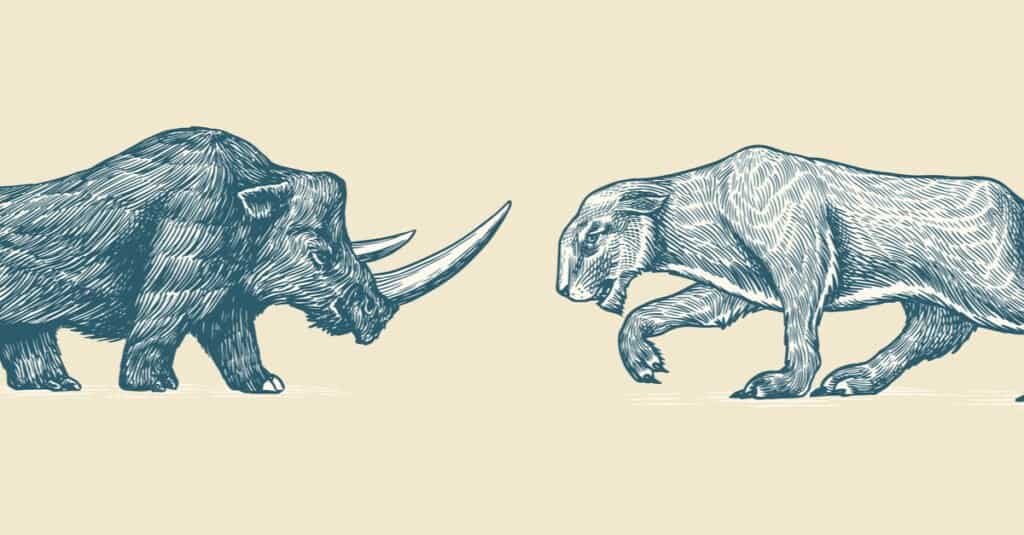
European cave lions are related to the American lion.
©Arthur Balitskii/Shutterstock.com
Similar animals to the Panthera atrox include:
- Panthera spelaea — This Panthera species is also known as the Eurasian cave lion or European cave lion. It lived in Europe about 600,000 years ago and went extinct in the early Holocene epoch roughly 13,000 years ago.
- Panthera leo — Commonly referred to as lion, Panthera leo is the closest living relative of the American lion. This large cat is native to Africa and Asia. It is about 25 percent smaller than the Panthera atrox.
- Smilodon — This is an extinct genus of saber-toothed cats that lived in the Americas during the Pleistocene Epoch. They’re close relatives of modern tigers but were bigger than they were. The most notable feature of this group of cats was their exceptionally long upper canine teeth.
Related Animals
View all 192 animals that start with PPanthera atrox (American Lion) FAQs (Frequently Asked Questions)
When was the Panthera atrox alive?
The American lion lived in North America from the Pleistocene Epoch till the early Holocene epoch. It probably evolved around 340,000 years ago and went extinct roughly 11,000 years ago.
How big was Panthera atrox?
Panthera atrox was about 25 percent bigger than modern lions. This makes it one of the biggest known members of the cat family. It measured about 5 ft 3 inches to 8 ft 2 inches from the tip of the nose to the base of the tail and stood at about 3.9 ft at the shoulder. Weight estimates for this lion vary between 564 and 930 pounds.
Why did the American lion go extinct?
By the end of the last ice age that took place in North America about 12,000 years ago, as many as 60 mammalian species went extinct. The American lion was one of them. Experts believe a combination of climate change and human activities led to their extinction.
Thank you for reading! Have some feedback for us? Contact the AZ Animals editorial team.
Sources
- Wikipedia, Available here: https://en.wikipedia.org/wiki/American_lion
- The Extinctions, Available here: https://www.theextinctions.com/panthera-atrox
- Libguides, Available here: https://ielc.libguides.com/sdzg/factsheets/extinctamericanlion

















